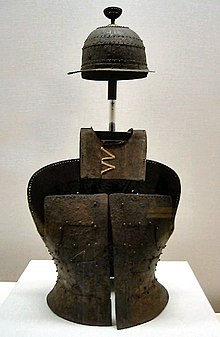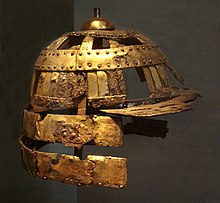Tankō
Tankō ( Japanese 短 甲 ) also "Gaya armor", "Silla armor" is a form of Japanese armor , as it was common in the Kofun period .
Tankō
The tankō (literally "short shell") is the first definable armor in Japan. Other types that were previously worn ( Japanese Jòdai no Katchù (ancient armor, according to the description of the armor historian Suenaga Masao)) are mentioned, but not verifiable. The tankō was made of sheet iron and tanned leather , with it laced at the waist to adapt it to the body of the wearer. The leather served as a support for the iron sheets and as a protective and lining in order not to damage clothing and skin. The iron sheets were riveted onto the leather armor in strips, overlapping or side by side . The back armor was made higher than the breastplate and thus formed a protection for the neck. The front was open and could be closed after tightening. It was fastened to the body using strips of fabric that ran over the shoulders. It is believed that this type of armor was influenced by Chinese infantry armor of the time.
Keikō
Another Japanese type of armor from the Kofun period, the keikō (literally "hanging bowl"), is influenced by the protective clothing of the mounted nomads of northern China. It was also used in Japan as armor for mounted armed forces, as the use of cavalry increased in importance during this period. The difference to the tankō consists of the keikō only in the upper area around the chest made of iron bands, while the lower part, in some versions also the entire armor, consists of metal lamellas , which were attached in overlapping rows. The leather lower armor was also used in this form of armor. The lamellas were fastened by riveting or by fastening them together with the help of leather straps.
Helmets
The helmets (Japanese Mabisashi) that were worn with this armor are known in two versions. The first consists of sheet iron strips , which were made overlapping similarly to the Tankō (Japanese Kondu Maruhachi). Pieces of lamellae were riveted onto the horizontally lying strips, which in this form formed the helmet shell. A short eye shield, which was often openwork , was attached to the front . On the top of the dome was a small hump with a fastening pin for a helmet bush.
The second version is worked differently. It has a helmet shell that consists of horizontal and vertical bands throughout. The eye shield and the attachment for the helmet bush are much larger. The attachment has a shell-shaped elaboration at the upper end, which is also used to attach and accommodate the helmet sleeve.
sign
The shield that was worn with this armor was made of sheet iron that was attached to a wooden base. The fastening of the shield components and the fastening on the shield body was done by riveting. The outside is slightly convex and decorated with triangular and linear patterns.
The terms Tankō and Keikō are not historically, but only later by archeology . In the Tōdai-ji's book of sacrifices from 756, Tankō and Keikō are recorded as gifts, and these terms were then assigned to types of excavated armor.
literature
- 講 談 社, Japan. An illustrated encyclopedia. Volume 1: A - L. Kodansha, Tokyo 1993, ISBN 4-06-206489-8 .
- William Wayne Farris: Sacred texts and buried treasures. Issues in the historical archeology of ancient Japan. University of Hawai'i Press, Honolulu HI 1998, ISBN 0-8248-1966-7 .
- Karl F. Friday: Samurai, warfare and the state in early medieval Japan. Routledge, New York NY et al. 2004, ISBN 0-415-32962-0 , pp. 186, 187.
- Thomas Louis, Tommy Ito: Samurai. The Code of the Warrior. Sterling Publishing Company, New York NY 2008, ISBN 978-1-4027-6312-0 .
Individual evidence
- ^ A b William Wayne Farris: Sacred texts and buried treasures. 1998, p. 76.
- ^ Anthony J. Bryant: Early Samurai. 200-1500 AD (= Osprey Military. Elite Series 35). Color Plates by Angus McBride. Osprey Publishing, London 1991, ISBN 1-85532-131-9 , pp. 28-29.
- ↑ Lars Vargö: Social and economic conditions for the formation of the early Japanese state (= Japanological Studies. Vol. 1). Stockholm University, Institute of Oriental Languages, Dept. of Japanese and Korean, Stockholm 1982, ISBN 91-7146-193-0 , p. 26.
- ↑ Kofun helmet in the Metropolitan Museum, available online, (accessed September 23, 2011)
- ↑ Kofun helmet in the Metropolitan Museum, New York, available online, (English, accessed on 23 September 2011)
- ^ Catharina Blomberg: The heart of the warrior. Origins and religious background of the Samurai system in feudal Japan. Japan Library, Sandgate 1994, ISBN 1-873410-13-1 , p. 1.




